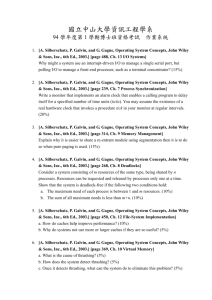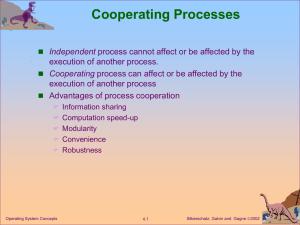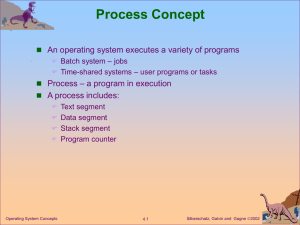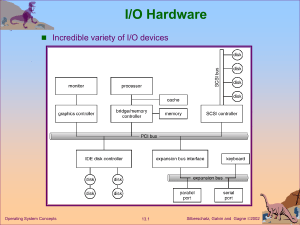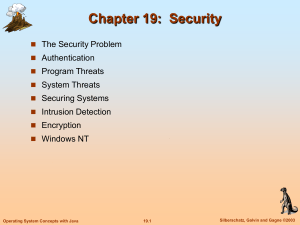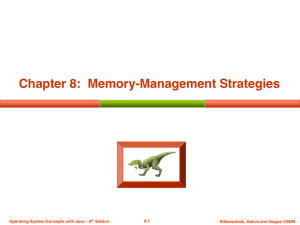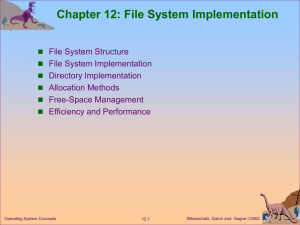Implementation of Page Table
advertisement
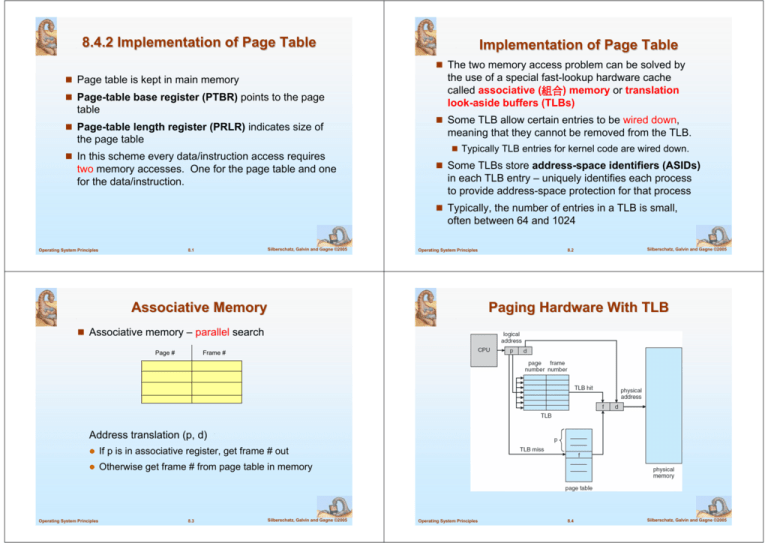
8.4.2 Implementation of Page Table Implementation of Page Table The two memory access problem can be solved by Page table is kept in main memory Page-table base register (PTBR) points to the page table Page-table length register (PRLR) indicates size of the page table In this scheme every data/instruction access requires two memory accesses. One for the page table and one for the data/instruction. the use of a special fast-lookup hardware cache called associative (組合) memory or translation look-aside buffers (TLBs) Some TLB allow certain entries to be wired down, meaning that they cannot be removed from the TLB. Typically TLB entries for kernel code are wired down. Some TLBs store address-space identifiers (ASIDs) in each TLB entry – uniquely identifies each process to provide address-space protection for that process Typically, the number of entries in a TLB is small, often between 64 and 1024 Silberschatz, Galvin and Gagne ©2005 8.1 Operating System Principles Operating System Principles Associative Memory 8.2 Silberschatz, Galvin and Gagne ©2005 Paging Hardware With TLB Associative memory – parallel search Page # Frame # Address translation (p, d) z If p is in associative register, get frame # out z Otherwise get frame # from page table in memory Operating System Principles 8.3 Silberschatz, Galvin and Gagne ©2005 Operating System Principles 8.4 Silberschatz, Galvin and Gagne ©2005 Effective Access Time Example Memory Protection Memory protection implemented by associating protection Associative Lookup = 20 nanoseconds Assume memory cycle time is 100 nanoseconds Hit ratio – percentage of times (次數) that a page number is found in the associative registers; ratio related to number of associative registers bits with each frame. z For example, one bit can define a page to be read-write or read-only. z The approach could be expanded to a finer level of protection Let Hit ratio = α Valid-invalid bit attached to each entry in the page table: Effective Access Time (EAT) EAT = (100 + 20)* α + (200 + 20)(1 – α) = 220 – 100 * α Operating System Principles 8.5 Silberschatz, Galvin and Gagne ©2005 z “valid” indicates that the associated page is in the process’ logical address space, and is thus a legal page z “invalid” indicates that the page is not in the process’ logical address space 8.6 Operating System Principles Silberschatz, Galvin and Gagne ©2005 Shared Pages Valid (v) or Invalid (i) Bit In A Page Table Shared code z One copy of read-only (reentrant) code shared among processes (i.e., text editors, compilers, window systems). z Shared code must appear in same location in the logical address space of all processes Private code and data z Each process keeps a separate copy of the code and data z The pages for the private code and data can appear anywhere in the logical address space A program with logical addresses 0 to 10468. Note that a logical address of 10568 is ‘valid’, but it will be blocked by limit register. Operating System Principles 8.7 Silberschatz, Galvin and Gagne ©2005 Operating System Principles 8.8 Silberschatz, Galvin and Gagne ©2005 Shared Pages Example 8.5 Structure of the Page Table Hierarchical Paging z Break up the logical address space into multiple page tables z A simple technique is a two-level page table, in which the page table itself is also paged page number p1 10 page offset p2 d 10 12 where p1 is an index into the outer page table, and p2 is the displacement within the page of the outer page table 8.9 Operating System Principles Silberschatz, Galvin and Gagne ©2005 Operating System Principles Two-Level Paging Example 8.10 Silberschatz, Galvin and Gagne ©2005 Address-Translation Scheme A logical address (on 32-bit machine with 4K page size) is divided into: z a page number consisting of 20 bits z a page offset consisting of 12 bits Since the page table is paged, the page number is further divided into: z a 10-bit page number z a 10-bit page offset of the outer pager table Since address translation works from outer page table inward, it is also known as forward-mapped page table. Operating System Principles 8.11 Silberschatz, Galvin and Gagne ©2005 Operating System Principles 8.12 Silberschatz, Galvin and Gagne ©2005 Two-Level Page-Table Scheme Three-level Paging Scheme For a system with 64-bit logical address space, the following should be avoided: Too many levels would require too many number of memory accesses To translate each logical address. Operating System Principles 8.13 Silberschatz, Galvin and Gagne ©2005 Operating System Principles Hashed Page Tables 8.14 Silberschatz, Galvin and Gagne ©2005 Hashed Page Table Common in address spaces > 32 bits The virtual page number is hashed into a page table. This page table contains a chain of elements hashing to the same location. Virtual page numbers are compared in this chain searching for a match. If a match is found, the corresponding physical frame is extracted. A variation uses cluster page tables, where each entry in the hash table refers to several pages (such as 16) rather than a single page Operating System Principles 8.15 Silberschatz, Galvin and Gagne ©2005 Operating System Principles 8.16 Silberschatz, Galvin and Gagne ©2005 Inverted Page Table Architecture Inverted Page Table One entry for each real page of memory z Need only one inverted page table in a system Entry consists of the virtual address of the page stored in that real memory location, with information about the process that owns that page Decreases memory needed to store each page table, but increases time needed to search the table when a page reference occurs Use hash table to limit the search to one — or at most a few — page-table entries Hard to implement shared memory 8.17 Operating System Principles Silberschatz, Galvin and Gagne ©2005 Operating System Principles 8.6 Segmentation 8.18 Silberschatz, Galvin and Gagne ©2005 User’s View of a Program Memory-management scheme that supports user view of memory A program is a collection of segments. A segment is a logical unit such as: main program, procedure, function, method, object, local variables, global variables, common block, stack, symbol table, arrays Operating System Principles 8.19 Silberschatz, Galvin and Gagne ©2005 Operating System Principles 8.20 Silberschatz, Galvin and Gagne ©2005 Logical View of Segmentation Segmentation Architecture A logical address consists of a two tuple: 1 1 <segment-number, offset> Segment table – maps two-dimensional physical 4 addresses; each table entry has: 2 z base – contains the starting physical address where the segments reside in memory z limit – specifies the length of the segment 3 4 2 Segment-table base register (STBR) points to the 3 segment table’s location in memory Segment-table length register (STLR) indicates user space physical memory space number of segments used by a program; z Operating System Principles 8.21 Silberschatz, Galvin and Gagne ©2005 a segment number s is legal if s < STLR 8.22 Operating System Principles Segmentation Hardware Silberschatz, Galvin and Gagne ©2005 Segmentation Architecture Protection z With each entry in segment table associate: validation bit = 0 ⇒ illegal segment read/write/execute privileges Protection bits associated with segments; code sharing occurs at segment level Since segments vary in length, memory allocation is a dynamic storage-allocation problem A segmentation example is shown in the following diagram Operating System Principles 8.23 Silberschatz, Galvin and Gagne ©2005 Operating System Principles 8.24 Silberschatz, Galvin and Gagne ©2005 Example of Segmentation 8.7 Example: The Intel Pentium Supports both segmentation and segmentation with paging CPU generates logical address z Given to segmentation unit Which z produces linear addresses Linear address given to paging unit Which generates physical address in main memory Paging Silberschatz, Galvin and Gagne ©2005 8.25 Operating System Principles Operating System Principles Logical to Physical Address Translation in Pentium units form equivalent of MMU 8.26 Silberschatz, Galvin and Gagne ©2005 Intel Pentium Segmentation segment number LDT/GDT protection s g 13 1 offset p 32 2 LDT: local descriptor table GDT: global descriptor table Each entry in LDT or GDT has 8-byte segment descriptor with detailed information about the segment, including the base location and limit of that segment Operating System Principles 8.27 Silberschatz, Galvin and Gagne ©2005 Operating System Principles 8.28 Silberschatz, Galvin and Gagne ©2005 Pentium Paging Architecture 8.8 Summary The following considerations are used in comparing different memory management strategies: skip 8.7.3 Operating System Principles 8.29 Silberschatz, Galvin and Gagne ©2005 z Hardware support z Performance z Fragmentation z Relocation z Swapping z Sharing z Protection Operating System Principles 8.30 Silberschatz, Galvin and Gagne ©2005
